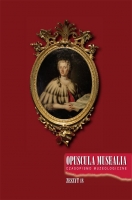Skandynawski wieczny kalendarz ze zbiorów Muzeum Uniwersytetu Jagiellońskiego w Krakowie
The Scandinavian clog calendar at the Jagiellonian University Museum
Author(s): Tadeusz W. LangeSubject(s): Fine Arts / Performing Arts
Published by: Wydawnictwo Uniwersytetu Jagiellońskiego
Keywords: Museums; University Museums; University Collections
Summary/Abstract: The idea of a convenient perpetual calendar emerged in the Middle Ages in geographical areas with limited access to clergymen, who, equipped with liturgical calendars and the so-called Paschal tables (used to set the dates of movable feasts), enforced the Third Commandment on behalf of the Catholic Church. The need for a handy tool that enabled an illiterate user to track the calendar independently arose in remote mountainous areas, cut-off from ecclesiastic outposts by the prolonged winter seasons. For the tools in question, the days of the year were usually carved on wood, and, above or beneath them, special marks were made for days devoted to assorted Catholic martyrs and saints. Each month had a few such festivals, to be “kept holy” along with Sundays and the movable feasts.
Journal: Opuscula Musealia
- Issue Year: 2010
- Issue No: 18
- Page Range: 91-99
- Page Count: 10
- Language: English

